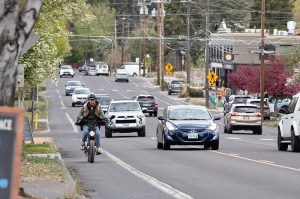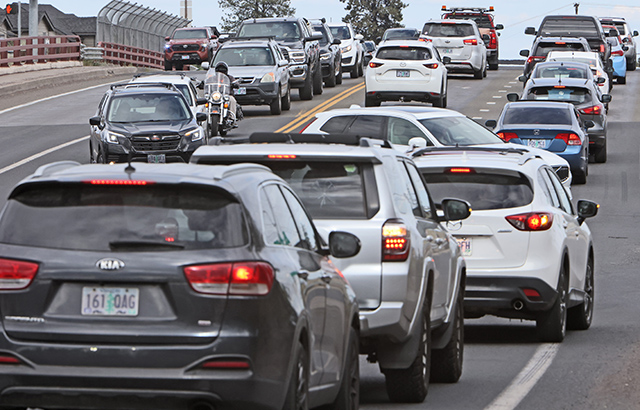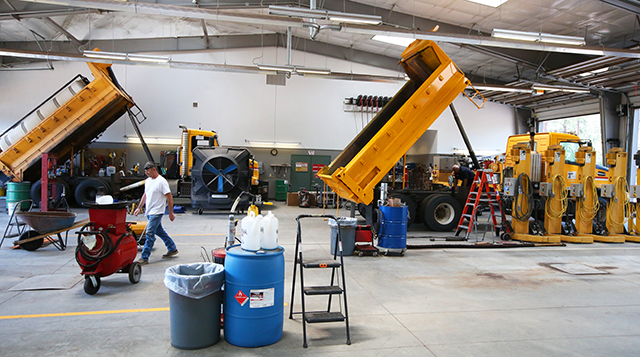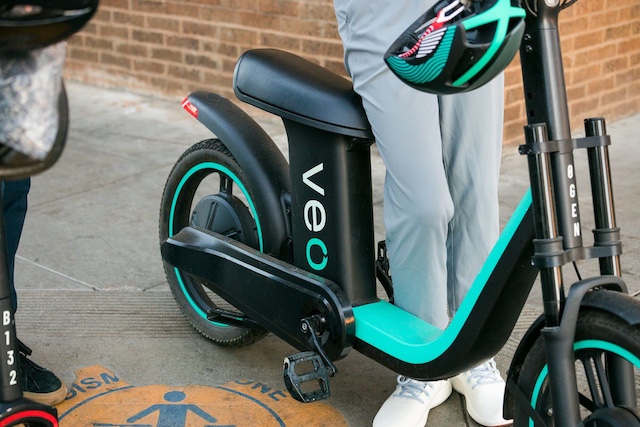Galveston Avenue safety project at a crossroads
Published 7:30 am Wednesday, May 7, 2025

- Cyclists ride across NW Galveston Avenue on Friday in Bend. 05/02/25 (Joe Kline/The Bulletin)
Bend corridor redesign is having an identity crisis
The city of Bend has intended to redesign a bustling business corridor on the west side for more than a decade. But now it’s unclear if they match the community and city council’s evolving expectations on transportation safety.
As of Tuesday, construction on the Galveston Corridor Project — a “comprehensive redesign” meant to slow cars and enhance bicycle and pedestrian safety on Galveston Avenue — is set to begin later this year. Based on current designs, it would narrow car lanes, add buffers to bike lanes, widen sidewalks and add parking, crosswalks and medians on some parts of the street.
According to the city’s website, the current $2 million design would make Galveston Avenue “a complete street, one that is designed, operated, and maintained to enable safe, convenient and comfortable travel and access for users.”
Trending
But some transportation advocates say there is potential to do much more to protect bicyclists and pedestrians, and that proceeding with the current design would only set the city back.
The city council still has to decide: “Is this still a good project at $2 million dollars to deliver, or is this going to miss the mark?” said Ryan Oster, the city’s lead engineer.
Oster met with city councilors Ariel Méndez and Gina Franzosa Tuesday to discuss what the city’s options are for proceeding with Galveston Avenue.
Last spring, Oster pitched a plan to the city council to finally dust off a project that had been sitting on the shelf since before the COVID-19 pandemic brought construction to screeching halt. The public process for Galveston first began in about 2014, and final plans weren’t approved until 2020. The plans included both the street makeover and stormwater improvements for a total of $8 million to $9 million. But the city only ever had money budgeted for the $4 million in transportation work, not the other infrastructure.
With the city council’s heightened focus on safety, Oster suggested the city scrap the underground work and move forward with a slightly modified design that would cost only $2 million but add a raised crosswalk at 12th Street. That would be a “pretty significant difference” in terms of safety, he said.
“We know people have gotten hurt there,” he said.
Trending
The $2 million option would allow the city to reallocate funding to other road projects, including construction on Olney Avenue and the Bend Bikeways project, an initiative to create biking routes stretching across the city.
That’s one example of Bend’s push to make biking and walking a safer option for people as the city grows. The effort is aided by a $190 million transportation bond voters approved in 2020, $43 million of which is earmarked for bicycle and pedestrian projects. Earlier this year, the city council set a goal to have zero deaths on Bend streets. The city recently started the process for updating new standards for Bend’s streets to align with changing priorities, just six months after the last update to the standards was approved in 2024.
During that discussion, Councilor Méndez said he wanted to “unleash the floodgates on safety.”
In a text message prior to his meeting with the city engineer, he said: “We’re still learning about the options. If we can do something that is cheaper, safer, and has less impact on businesses and residents in terms of closure, I think we’ll want to look at that.”
Some say Galveston’s plans could do much more to improve safety.
“It’s about a 10-year-old project, and it looks like that,” said David Green, a board member of Bend Bikes, a bicycle and pedestrian safety advocacy group.
Current designs show an 8-foot section of street for landscaping and parking between the sidewalk and the bike lane. Green said moving the landscaping to the other side of the bike lane would create an adequate buffer so people of all ages and abilities could safely ride there. The design would also benefit from a series of raised pedestrian crossings, with extra focus on the crossing nearest to the Deschutes River and the Galveston bridge. A raised bike lane would also add safety, he said.
Green argued that Bend’s west side has grown so much since the city started designing the project that approving the old designs would only set the city back.
The Galveston design process began several years before any of the current city councilors took office. Bend’s longest-serving elected officials Bend took office in 2020.
“By starting out 10 years behind, we’re not moving towards the street design that we really want. We’re moving toward the street design we thought was adequate 10 years ago with very different traffic patterns and development on the west side,” he said.

A person rides in the bike lane as vehicles travel along NW Galveston Avenue on Friday in Bend.
05/02/25 (Joe Kline/The Bulletin)
There are valid points to be made about the age of the design, Oster said.
“This design is probably a little outdated compared to what the expectation is today,” he said.
But sending the Galveston project back to the drawing board for a new design would not only mean delays, but cost increases as well. Méndez said he loves the ideas about more dramatic safety changes to the design, but those would put the project over budget. He would prefer smaller tweaks that would improve safety and maybe even reduce cost by further scaling back the project, he said.
The city could complete the current designs without closing Galveston, starting this fall with sidewalk work while completing the roadwork portion next spring, Oster said.
That would be a welcome timeline for Nicole Weston-James, who has managed the Westside Tavern on Galveston since 2010. The business has been waiting for 10 years for the project to move forward, and has little clarity as of late about whether it will. Safety improvements on the busy streets are sorely needed, she said.
“I’ve almost gone out and painted my own crosswalks,” she said.
In 2014, Weston-James and a few other Galveston business owners joined the committee tasked with workshopping designs for the project. Settling on a design wasn’t easy, she said.
“I’m hoping they are going to use the design that was agreed upon,” Weston-James said. “It took so long and there was so much compromise on everybody’s part. I feel like the design that they accepted was a compromise everybody could live with.”
She said she appreciated how the current design allowed her to choose whether to use the space outside of her bar in between the sidewalk and bike lane as either extra seating or parking.
With 8-foot sidewalks and 5-foot bike lanes, the design already allocates more space for people than cars, she said. She fears that going even further might end up driving people away from Galveston.









